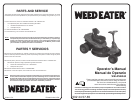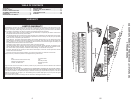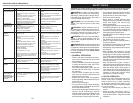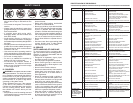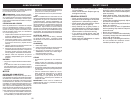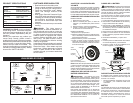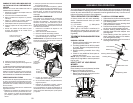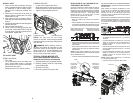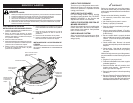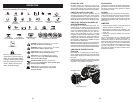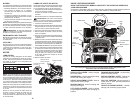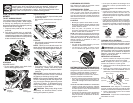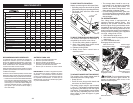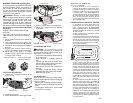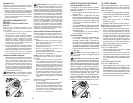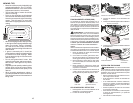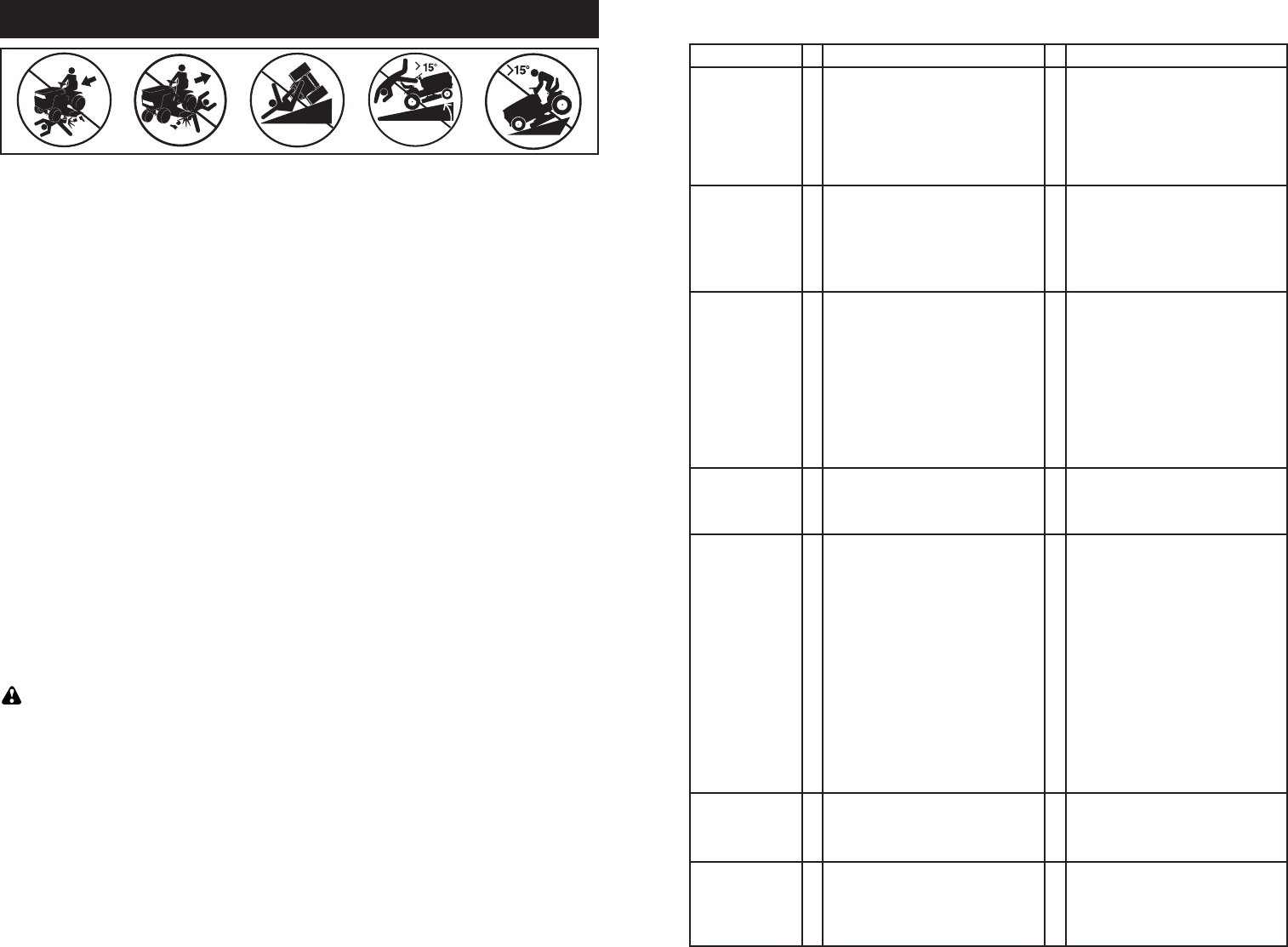
4
• Choose a low ground speed so that you
will not have to stop or shift while on the
slope.
• Do not mow on wet grass. Tires may lose
traction.
• Always keep the machine in gear when
going down slopes. Do not shift to neutral
and coast downhill.
• If machine stops while going uphill,
disengage blade, shift into reverse and
back down slowly.
• Avoid starting, stopping, or turning on a
slope. If the tires lose traction, disengage
the blade and proceed slowly straight down
the slope.
• Keep all movement on the slopes slow and
gradual. Do not make sudden changes in
speed or direction, which could cause the
machine to roll over.
• Use extra care while operating machine
with grass catchers or other attachments;
they can affect the stability of the machine.
• Do no use on steep slopes.
• Do not try to stabilize the machine by
putting your foot on the ground.
• Do not mow near drop-offs, ditches, or
embankments. The machine could sud-
denly roll over if a wheel is over the edge
or if the edge caves in.
III. CHILDREN
WARNING: CHILDREN CAN BE INJURED
BY THIS EQUIPMENT. The American Acade-
my of Pediatrics recommends that children
be a minimum of 12 year of age before op-
erating a pedestrian controlled lawn mower
and a minimum of 16 years of age before
operating a riding lawn mower.
Tragic accidents can occur if the operator
is not alert to the presence of children.
Children are often attracted to the machine
and the mowing activity. Never assume
that children will remain where you last
saw them.
• Keep children out of the mowing area and
in the watchful care of a responsible adult
other than the operator.
• Be alert and turn machine off if a child
enters the area.
• Before and while backing, look behind
and down for small children.
• Never carry children, even with the blade
shut off. They may fall off and be seriously
injured or interfere with safe machine
operation. Children who have been given
rides in the past may suddenly appear in
the mowing area for another ride and be
run over or backed over by the machine.
• Never allow children to operate the ma-
chine.
• Use extra care when approaching blind
corners, shrubs, trees, or other objects
that may block your view of a child.
IV. SERVICE
SAFE HANDLING OF GASOLINE
To avoid personal injury or property dam-
age, use extreme care in handling gasoline.
Gasoline is extremely flammable and the
vapors are explosive.
• Extinguish all cigarettes, cigars, pipes,
and other sources of ignition.
• Use only approved gasoline container.
• Never remove gas cap or add fuel with
the engine running. Allow engine to cool
before refueling.
• Never fuel the machine indoors.
• Never store the machine or fuel container
where there is an open flame, spark, or
pilot light such as on a water heater or
other appliances.
• Never fill containers inside a vehicle or
on a truck or trailer bed with plastic liner.
Always place containers on the ground
away from your vehicle when filling.
• Remove gas-powered equipment from the
truck or trailer and refuel it on the ground.
If this is not possible, then refuel such
equipment with a portable container, rather
than from a gasoline dispenser nozzle.
• Keep the nozzle in contact with the rim
of the fuel tank or container opening at
all times until fueling is complete. Do not
use a nozzle lock-open device.
SAFETY RULES
53
PROBLEMA CAUSA CORRECCIÓN
No arranca
1
No tiene combustible.
1
Llene el tanque de combustible.
2
Bujía defectuosa.
2
Cambie la bujía.
3
Filtro de aire sucio.
3
Limpie/cambie el filtro de aire.
4
Agua en el combustible.
4
Vacíe el tanque de combustible y el carb-
urador, rellene el tanque con gasolina
nueva y cambie el filtro de combustible.
5
Cableado suelto o dañado.
5
Revise todo el cableado.
6
Las válvulas del motor están desajustadas.
6
Contacte un centro de servicios autorizado.
Dificultad para
arrancar
1
Filtro de aire sucio.
1
Limpie/cambie el filtro de aire.
2
Bujía defectuosa.
2
Cambie la bujía.
3
Batería baja o muerta.
3
Recargue o cambie la batería.
4
Combustible viejo o sucio.
4
Vacíe el tanque de combustible y rellénelo
con gasolina nueva y limpia.
5
Cableado suelto o dañado.
5
Revise todo el cableado.
6
Las válvulas del motor están desajustadas.
6
Contacte un centro de servicios autorizado.
El motor no
da vueltas
1
El freno del embrague/freno no está
presionado.
1
Presione el pedal del emgrague/freno.
2
El embrague de la plataforma está
activado.
2
Desactive el embrague de la plataforma.
3
Batería baja o muerta.
3
Recargue o cambie la batería.
4
Fusible fundido.
4
Cambie el fusible.
5
Terminales de batería con corrosión.
5
Limpie las terminales de la batería.
6
Cableado suelto o dañado.
6
Revise todo el cableado.
7
Interruptor de arranque defectuoso.
7
Revise/cambie el interruptor de arranque.
8
Solenoide o arranque defectuoso.
8
Revise/cambie el solenoide o arranque.
9
Interruptor(es) de presencia de operador
defectuoso(s).
9
Contacte un centro de servicios autorizado.
El motor
chasquea pero no
arranca
1
Batería baja o muerta.
1
Recargue o cambie la batería.
2
Terminales de batería con corrosión.
2
Limpie las terminales de la batería.
3
Cableado suelto o dañado.
3
Revise todo el cableado.
4
Solenoide o arranque defectuoso.
4
Revise/cambie el solenoide o arranque.
Pérdida de
energía
1
Corte de demasiado césped/demasiado
rápido.
1
Eleve la altura de corte/reduzca la
velocidad.
2
Acumulación de césped, hojas y basura
debajo de la cortadora de césped.
2
Limpie la parte inferior de la carcasa de la
cortadora de césped.
3
Filtro de aire sucio.
3
Limpie/cambie el filtro de aire.
4
Nivel bajo de aceite/aceite sucio.
4
Revise el nivel de aceite/cambie el aceite.
5
Bujía defectuosa.
5
Limpie y ajuste o cambie la bujía.
6
Combustible viejo o sucio.
6
Vacíe el tanque de combustible y rellénelo
con gasolina nueva y limpia.
7
Agua en el combustible.
7
Vacíe el tanque de combustible y el
carburador y rellene el tanque con gasolina
nueva.
8
Cable de la bujía suelto.
8
Conecte y ajuste el cable de la bujía.
9
Pantalla/aletas de aire del motor sucias.
9
Limpie la pantalla/aletas de aire del motor.
10
Silenciador sucio/obstruido.
10
Limpie/cambie el silenciador.
11
Cableado suelto o dañado.
11
Revise todo el cableado.
12
Las válvulas del motor están desajustadas.
12
Contacte un centro de servicios autorizado.
Vibración
excesiva
1
Cuchilla desgastada, doblada o suelta.
1
Cambie la cuchilla. Apriete el perno de la
cuchilla.
2
Mandril de cuchilla doblado.
2
Contacte un centro de servicios autorizado.
3
Parte(s) suelta(s)/dañada(s).
3
Apriete la(s) parte(s) suelta(s)/dañada(s).
Cambie las partes dañadas.
El motot sigue
funcionando
cuando el opera-
dor deja el asiento
con elembrague
activado
1
Sistema de control de presencia de
seguridad del operador defectuoso.
1
Revise el cableado, los interruptores y las
conexiones. Si no son correctos, Contacte
un centro de servicios autorizado.
IDENTIFICACIÓN DE PROBLEMAS:
Vea la sección apropiada en el manual a menos que esté dirigido a un centro de servicio autorizado.



